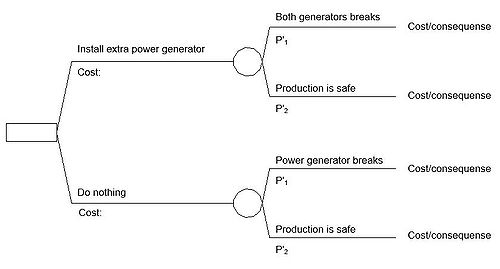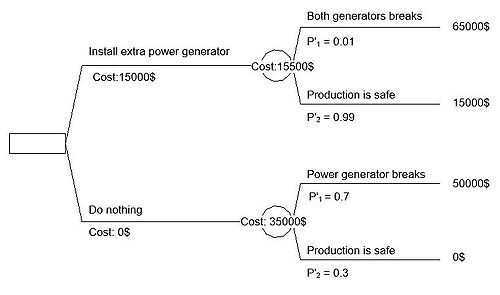Decision Tree: Risk & Opportunities
(→Application of the method) |
(→Application of the method) |
||
| Line 23: | Line 23: | ||
== Application of the method== | == Application of the method== | ||
| − | Using the medicinal company's decision problem an example will be presented with the use of | + | Using the medicinal company's decision problem an example will be presented with the use of a Bayasian decision analysis<ref name="Probability" /> |
| − | === Decision analysis | + | === Decision analysis - Prior analysis=== |
| − | + | To complete the decision tree information as cost of each stage and the percentage of each event happening must be estimated. | |
| − | + | For this case the extra power generator cost 15000 $ to install and the aftereffect of the generator breaking down cost 50000 $<br> | |
| − | To complete the decision tree information as cost of each stage and the percentage of each event happening must be | + | |
| − | For this case the extra power generator cost 15000 $ to install and | + | |
If no action is taken there is a 30% chance that the production is safe and 70% it is not.<br> | If no action is taken there is a 30% chance that the production is safe and 70% it is not.<br> | ||
By installing the generator the production has a 99% to be safe. With really bad luck there is 1% chance that both the generators break down. | By installing the generator the production has a 99% to be safe. With really bad luck there is 1% chance that both the generators break down. | ||
Revision as of 13:19, 21 September 2017
Contents |
Abstract
Uncertainty is a massive issue in project management and can lead to high cost and disadvantages if not handled correctly. The project manager must therefore be able to make the best decisions based on the information available.
The decision tree is a tool that can aid the project manager to ensure the best outcome of a problem.
It is based on a tree-like model where each branch is a path of decisions and possible events. Each step include the cost and possibility of that event to occur.
By identifying all the possible events and their chance to occur it gives the project manager the ability to calculate the highest probability for each path.
When combining this with the cost of each event the project manager is able to estimate the cost/benefits for each decision.
Method Description
The decision tree is a method to evaluate a decision making process within a project. By using the Bayesion decision analysis the user is able to mitigate the risk and cost of the decision.
It is useful when analyzing a process that has a combination of many decisions as the user is able to calculate the effect of each decision.
The decision tree is a model with three types of stages:
● A decision node (square)
● A event node (circle)
● A cost/consequence node
At the decision node the project manager has to take an active choice to move on. The event node the effect that can happen from a choice taken. The last type of node is the cost/consequence which is the end result of decisions and events occurring.
Figure 1 shows the basic decision problem situation. It is a medicinal company that is investigating if they should install an extra power generator. If the power generator breaks down they would have to shut down production until it is fixed. A shut down could lead to massive expenses and on the same time investing in an extra power generator is also expensive.
First the decision node is whether they should install the power generator or not. Both the decisions leads to an event where there is a chance of two possible outcomes.
Application of the method
Using the medicinal company's decision problem an example will be presented with the use of a Bayasian decision analysis[1]
Decision analysis - Prior analysis
To complete the decision tree information as cost of each stage and the percentage of each event happening must be estimated.
For this case the extra power generator cost 15000 $ to install and the aftereffect of the generator breaking down cost 50000 $
If no action is taken there is a 30% chance that the production is safe and 70% it is not.
By installing the generator the production has a 99% to be safe. With really bad luck there is 1% chance that both the generators break down.


Limitations
Alternatives
Annotated Bibliography
References
- ↑ Michael Havbro (2010) Statistics and Probability Theory - In Pursuit of Engineering Decision Support, Publisher : Springer International Publishing.

